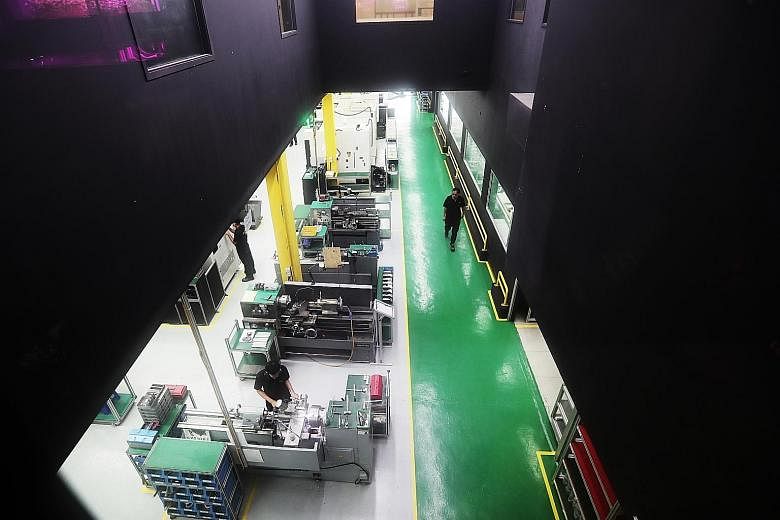Singapore's factory output shrank 1.4 per cent last year in its worst performance since 2016, according to data released by the Economic Development Board yesterday.
But electronics production squeezed out a small gain last month, breathing life into hopes that the crucial sector's output decline has hit the floor and will continue to recover through the year.
For December, overall manufacturing output was 0.7 per cent lower from a year ago, better than the 8.9 per cent slump in November - revised from a 9.3 per cent slide. Excluding biomedical manufacturing, output fell 3.2 per cent last month.
The latest figures were almost in line with expectations, with analysts polled by Bloomberg having tipped December's output to drop 0.6 per cent year on year.
Electronics output, which accounts for over a quarter of Singapore's factory production, managed a 0.2 gain last month, recovering from a 22.2 per cent slide the previous month. That still left the cluster with a full-year contraction of 7.4 per cent.
The uplift of the sector last month was due to the data storage segment which expanded by a whopping 42.6 per cent. The modules and components segment rose 12.4 per cent. The semiconductors segment, which represents about 17 per cent of electronics manufacturing, increased by just 1 per cent.
Maybank economist Lee Ju Ye said overall manufacturing, especially in the electronics sector, was finally getting in line with improvements seen in recent data from regional electronics powerhouses such as South Korea and Taiwan.
"It seems like the electronics recovery cycle story is back on track," she said. "Demand for semiconductors will increase as 5G network roll-outs begin in Asean and across the world this year.
"We don't expect a big spike. The recovery will shape gradually, with the second half of the year likely to be more positive for semiconductors."
Biomedical manufacturing expanded 10.3 per cent last month from a year earlier, with the medical technology segment growing 20 per cent due to higher export demand for medical devices.
Overall, the biomedical cluster's output rose 10.7 per cent last year.
-
0.2%
-
Gain in electronics output last month, an improvement from the 22.2 per cent fall the previous month.
-
1%
-
Increase last month in the semiconductors segment, which represents about 17 per cent of electronics manufacturing.
Among clusters, the largest decline was seen in transport engineering, which fell 14.1 per cent year on year in December, as the marine and offshore engineering segment declined 31.2 per cent amid depressed levels of offshore and shipbuilding activities.
Land and aerospace segments, however, expanded 28.1 per cent and 1.2 per cent, respectively.
For the full year, output of the transport engineering cluster contracted 1.8 per cent.
General manufacturing output fell 10 per cent on the back of a 20.2 per cent fall in food, beverages and tobacco. However, its full-year output grew 1.5 per cent.
Chemicals output decreased 5.2 per cent, with the hardest-hit petrochemical production falling 8.5 per cent owing to maintenance shutdowns. The cluster's full-year output dropped 2 per cent.
Precision engineering's full-year output fell 2.5 per cent.
On a seasonally adjusted month-on-month basis, total manufacturing output rose 4.1 per cent last month. Excluding biomedical, output grew 1.1 per cent.
United Overseas Bank (UOB) noted that Singapore had indeed seen a period of stabilisation in the last quarter. The full-year output drop was at a milder pace than during the 2008/2009 financial crisis, when output fell 4.2 per cent for two consecutive years, said UOB economist Barnabas Gan.
"We remain cautiously optimistic for Singapore's manufacturing momentum to expand 0.5 per cent in 2020, which should lift overall economic growth to 1.5 per cent."


